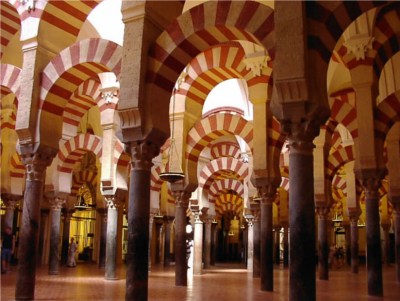Words like alcohol, cotton, elixir, nadir, zenith, almanac, zero, jasmine, saffron and coffee have nothing special in common - except their origin.
They all have their roots in Arabic and their arrival in our vocabulary date back to the time of the Moors, those invaders who stormed across the Mediterranean 13 centuries ago to lay siege to Europe. The Moors - a term that includes Arabs and Berbers - left an indelible mark on southern Spain in particular.
Travel through the region of Andalusia today and you will come across traces of their influence wherever you go. Spanish words like alcázar, alguacil, arroz, aduana, alcalde, naranja and azúcar are a part of that legacy. But so too are architecture, irrigation systems, customs.
The Moors brought to the Spanish peninsula (and over time to the rest of Europe) new crops such as bananas, almonds, apricots, peaches, aubergines and cucumbers. They also imported the Arabian steed and a new view of Aristotle, astronomy and medicine.
 Across Andalusia you will find place names inherited from the era of the caliphs, along with crumbling fortresses, horseshoe arches and brilliant ceramics. Minarets survive, converted into church towers when the mosques were torn down. Seville's 94-metre-high Giralda is the most striking example but there are many more.
Across Andalusia you will find place names inherited from the era of the caliphs, along with crumbling fortresses, horseshoe arches and brilliant ceramics. Minarets survive, converted into church towers when the mosques were torn down. Seville's 94-metre-high Giralda is the most striking example but there are many more.
Several mosques remain, from the colossal structure of 1,000 columns in Córdoba to an intimate building on a hillside at Almonaster la Real in Huelva province. While the magnificent Alhambra palace of Granada is the Moors' most impressive architectural legacy, the humble flat-roofed dwellings on the southern slopes of the Sierra Nevada are a direct inheritance from the Berbers of North Africa.
When Córdoba was a flourishing city 1,000 years ago, it spawned a series of notable intellects: philosophers Maimonides and Averroës, jurist and historian Ibn Hazm, Abdulcasis, author of the first illustrated book on surgery.
And then there was the extraordinary ninth-century musician and trend-setter, Ziryab. Born in Baghdad in 789, he was known as Ziryab (Blackbird) because of his dark complexion and fine voice. The songs he composed were said to have been "dictated by the angels".
He changed eating habits in Córdoba, ordaining that courses were no longer served haphazardly but in strict order, fruit and nuts coming last. And he introduced the fifth string to the Arab lute, contributing to its development into the six-string guitar.
Arab music strongly influenced flamenco and the cries of "Olé!" at a bullfight are almost certainly related to the "wa-Allah!" the Moors yelled during poetry recitals. The Arabs also introduced paper to Europe and Arabic numerals, which replaced the clumsy Roman system.
The next time you add up your shopping list imagine doing so in Roman numerals scratched on dried sheepskin.
Comments:
| Comment | Date | User |
| I enjoyed this article. My book "Vibrant Andalusia" (Algora Publishing, NY, 2007) covers this subject extensively. | 7/20/2011 3:48:00 PM | Ana Ruiz |
| Muy interesante Gracias
www.eliseevbrothers.com | 7/27/2019 4:52:47 PM | Masimomsm |